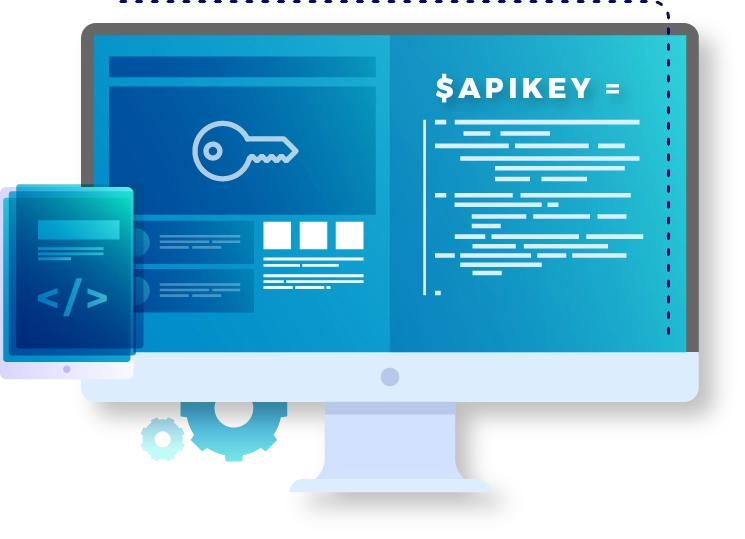Connect to our SMS API in 3 simple steps.

Create a free account
To start the process of using our SMS API service, complete our registration form in a few short seconds to create an account, join today via the connect button.

Receive your credentials
Once you have decided on how to connect to our platform, your unique username and password, or API key will be generated and emailed to you.

Integrate our SMS API
Use these unique account details alongside the example code and multi-language documentation via our developer pages to connect SMS functionality to your software.
How does our SMS API messaging work?.
With our user-friendly SMS API, it’s never been easier to integrate SMS into your software, or application. Join the hundreds of developers that have used our example code to quickly and successfully introduce SMS to their bespoke solutions. Our API is comprehensively supported with detailed information and full developer SMS code examples.
Our system is configured to connect directly with the networks to broadcast and receive text messages on your behalf. Once you have registered for an account, and we have provided your account credentials, choose the example code in your preferred language and insert your username and password, or API key, to start testing message delivery in a few minutes.
Additional API features
Designed to deal with high volumes of business texts, customers that fully integrate our text message API into their application or software are offered a true communication extension with additional engagement benefits; it works seamlessly with the technology they and their employees are already familiar with.

Single text, or bulk SMS campaigns
As an established operator, we guarantee the highest quality text service, capable of handling up to 600 messages per second. Whether you need to send a simple acknowledgement or an urgent update to your entire customer base, our integrated API is built to manage any volume or scale.

Personalised texts & trackable web-links
Using our API, you can customise the Sender ID of your messages and insert personalised fields, depending on how extensively your software is coded. This allows you to send the same templated message to multiple recipients while varying details such as name, date, and address. Or, include a fully trackable mini-URL link that is unique to every recipient, to evaluate the performance of your SMS marketing campaigns.

Receive message replies
In conjunction with a rented reply number assigned to your account, our SMS API allows you to receive text message replies back to your account, or if required, a nominated email address. Ideal for receiving official opted-in data for forthcoming events or promotions. Capture all messages, or segment into assigned groups by asking your customer to reply with a specific keyword.

Account management
Using our SMS API, you can do much more than just send and receive text messages. You can manage contacts, create or delete contact groups, create forwarding rules, request current account balances, create STOP lists, and obtain the delivery status of each of your messages. Sign-up today and test drive our SMS API system, we’ll even load your account with some free test credits.
Types of code.
Our system has been designed to work with all languages, including PHP, .NET, C#, Java, Python, Ruby, and many more. To quickly test our system in a few seconds, copy and paste the tabbed HTTPs GET or POST code on the API legacy, API key developer pages, and open a browser.
Replace the red fields with your username, password or API key, sender ID, mobile number, and test message content. Once you’ve entered the details, press ‘Enter’— your message will be delivered within seconds.
SMS API connection methods
We provide access to our SMS API via two specific but equally reliable methods. Depending on your set-up, or existing software code, you can quickly and easily connect to our system by using either a traditional username, password combination, or via unique API key integration.
-
API integration
When we refer to an API integration, or an API legacy integration we mean that your account has been created, and integration authorised via a username and password. These supplied credentials are then used when coding your integration to our system to provide authenticated access to your account. We find these types of integrations are required for pre-existing, or more established software solutions.
API legacy documentation
Once armed with your username and password for API integration, head over to our API documentation page, and choose your preferred programming language from the drop down.
-
API key integration
When we use the terminology API key, we indicate that your account isn’t integrated with our system via traditional username and password credentials but rather via a unique key, composed of alphanumeric characters that you insert directly into your code. This string is then used to authenticate access to your dedicated account to submit and receive your text messages to the mobile operators.
API key documentation
If you’ve opted to integrate our SMS messaging services using API key integration, click the button below to view our sample code documentation in multiple programming languages.
-
3-click switch migration
Have an SMS API integrated with someone else? Forget redevelopment, move over to Faretext by only having to change your credentials and endpoint details – it couldn’t be easier.
No matter who you’re with, we convert your existing API code to match ours.
Why choose faretext?.
Take a look at some of the main reasons why businesses choose to integrate with our SMS Messaging API:
Simplicity
During the initial set-up for integration via our SMS API, we determine the particulars of your solution and the terminating countries you wish to send messages to. We then design your integration in accordance with our API and the specific guidelines of each country. Any specific limitations or compliance you need to follow will also be provided prior to your first text being sent.
Direct routing
All messages sent through our SMS API, UK or International are submitted directly to the mobile network for processing. This guarantees that all SMS’s submitted via our system have the highest rate of delivery reliability, as well as the most efficient delivery speeds.
Transparency
Via our API, you can retrieve information of the final delivery status of every message submitted through our system. Through developed API calls, you can allow your software to register whether an outbound message was delivered, sent or failed.
Scalability
Our API allows businesses to seamlessly manage SMS communication with thousands of customers directly through their own software, without limitations — whether they have a small customer base or a large distribution list.
Fraud prevention
Our SMS API system uses active monitoring to prevent abuse and fraud through temporary suspensions and blocks, reducing risks like text bombing and inflated SMS traffic from revenue-share numbers.
Smart content
Our system can process multiple actions using a hosted reply number, based on triggered words received from text replies. This could be a simple use of a keyword to create a different database, or a generic outbound acknowledgement message, that is sent in event of any reply being received back to our system.
The SMPP high-volume solution.
Instead of connecting via our SMS API, customers have an alternative method to connect to Faretext, via our SMS SMPP service. Standing for Short Message Peer-to-Peer, this type of integration is used for broadcasting high-volumes of messages very quickly and directly to both, text aggregators and mobile network operators. Our server supports the industry-standard SMPP 3.4 and can process up to 600 messages per second.
Simultaneously the system can also receive delivery receipts, ensuring real-time delivery results of your bulk text campaigns.
To find out more about Faretext’s SMPP service, please get in touch, by filling in the form below or calling: 01142 945 993
Take the test.
Check the reliability and speed of our Direct route for free. Simply insert your UK mobile number and click Go.
API SMS messaging at faretext.
Take your organisation to the next level with our API SMS messaging at Faretext. Simply integrate your website, app, software or CRM application with our SMS API.
Contact our team of professionals today to discuss your text message API requirements.
SMS API FAQs.
-
What is an SMS API?
An SMS API, otherwise known as a Short Message Service Application Programming Interface, is a tool that allows software applications to send, receive and manage SMS messages programmatically. Essentially, it acts as a bridge between your application and an SMS gateway/system or service provider, enabling seamless communication without manual intervention.
-
How do you connect to our SMS API?
1 – Firstly, you’ll want to sign up to our SMS messaging service, and choose to connect via API or API key in the registration form.
2 – Upon receipt of your registration, we will then generate a unique API key or a username, password combination, and email this over.
3 – Depending upon your configuration and needs, we will provide further details to assist in getting the most from our system.
4 – For a quick preliminary connection test, take note of your newly acquired credentials or API key, and then insert these details into the example HTTPs code provided on the respective developer pages. You will need to supply a working and accessible mobile phone number, and a few other test details.
5 – First, open a web browser, copy and paste your personalised request, and then click return.
6 – Your test message is sent and received in a few seconds.
7 – Once you’re happy with the initial connection test and ready to integrate it into your software or application, access the relevant developer documentation page on our website and select example code in your preferred language.
8 – Copy and paste the code into your software solution, along with your account connection credentials or API key.
9 – Now it’s time to test your code! Verify that messages are being sent and received successfully by logging into your Faretext account on our website using the login details provided in our email.
10 – That’s it! Now enjoy communicating with your customers via the humble text message.
-
How does an SMS API work?
An SMS API makes it easy to send and receive large volume SMS and MMS messages from a web application via a HTTPs request. To put it simply, SMS APIs act as a connection between your app to the mobile operator networks. This allows you to send and receive text messages.
-
What is an SMS Gateway?
Officially, an SMS Gateway refers to a computer or server that hosts software required to send and receive text messages in the form of SMS (Short Message Service) or MMS (Multimedia Messaging Service) between local and international telecommunication networks. The gateway allows these messages to be pushed to a mobile phone via an appropriate mobile operator. Gateways are commonly used as a method of person-to-person to device-to-person (also known as application-to-person, or A2P) communication.
The terminology of SMS Gateway is often confused with SIM Gateway, or GSM Gateway, which relate to specialist hardware and installed software that utilise a bank of SIMs to send and receive text messages, instead of being submitted directly to the mobile network operators (MNO’s), or mobile virtual network operators (MVNO’s) for transmission.
To avoid confusion or any negative associations, and since this practice is frowned upon by mobile operators and governing bodies, we refer to our official SMS Gateway as our SMS System.
-
What types of messages can I send with your SMS API?
With our SMS API, you can send various types of messages tailored to your business needs, including:
Transactional messages – Delivering important updates or information (order confirmations, shipping updates, account notifications and password resets).
Reminders and SMS alerts – Help customers stay informed and organised (appointment reminders, payment due notices and event notifications). For transactional and reminder message examples we have implemented for our clients, please visit: SMS reminders
Promotional messages – Boost customer engagement and sales to your SMS subscribers (discounts and special offers, new product launches and marketing campaigns). For example promotional message solutions we have carried out on our customers behalf, please visit: SMS marketing
Two-way messages – Via a rented reply number or short code facilitate interaction with your customers (customer feedback surveys, support inquiries, confirmation responses, opt-ins, opt-outs).
-
Who can benefit from using an SMS API?
Any business or developer needing to send notifications, alerts, reminders, OTPs or marketing messages can benefit from using our SMS API
Here are some key industries that can benefit from SMS APIs:
eCommerce
Taxi & Private hire
Logistics & Delivery services
Event organisers
Healthcare providers
Travel & Hospitality
Retail
Estate agents
Recruitment
Motortrade
Health & Fitness clubs
Government & Public sector
Marketing & Advertising agencies
Customer service & Sales teams
Schools & Nurseries
Independent services
Non-profit organisations
-
Is your SMS API available worldwide?
Because our SMS API is digital, available online and provided in multiple programming languages, it is not confined by any country or region. This, combined with comprehensive access to a host of global mobile network operators, ensures flexibility in sending text messages. Wherever you are based or operate from, you can send messages to anyone who has registered for your service. This is provided that you adhere to applicable country-specific rules and legislation for SMS transmission and that your account is configured correctly.
-
Is your SMS API free to use?
Yes. In nearly all customer integrations, access and regular use of our SMS API is completely free-of-charge and will always remain that way.
The only exception to this rule is when further development or ongoing support is required to maintain the API for highly complex or bespoke solutions.
At Faretext, we are firm believers in transparency from the start. If a customisation of our existing but comprehensive API is required to better suit your needs, all associated costs will be quoted and agreed upon prior to any work being undertaken.
-
What are the main benefits of using SMS API?
Some further benefits of API SMS messaging include:
Relevance and timeliness – Our SMS API can be used for a variety of purposes, such as sending alerts, one-time passcodes for authentication, appointment reminders, and seasonal incentives.Improved communication – Once integrated, our API can assist with all of the end-users communication milestones as they travel through your sales process. This automatically keeps them informed at every step of their journey, without costly manual intervention.
Customer retention – Our SMS APIs enable businesses to send reminders, schedule marketing campaigns, or broadcast promotions and incentives to subscribers.
Customer engagement – SMS messaging via an API, with the option to include a reply number, helps businesses attract and engage customers at every stage of the buying cycle.
Automation – Integrating our SMS API can automate messaging, streamlining workflows and reducing communication time and costs.
Reporting – Every outbound and incoming message is recorded via our system. We are able to provide a full detailed report of every message sent detailing the respective final delivery status.
High ROI – Correct application of our SMS API saves time, resources, and costs by automating communication while ensuring customers stay informed and valued.
Sustainability – If your business operates a corporate responsibility scheme, it’s good to know that texts sent through our system are about the most environmentally-friendly and carbon-free communication systems available. Furthermore, if you plan to replace traditional printed and posted mediums with SMS messaging, not only will you be utilising the most popular, and recognised forms of customer interaction, you also save significant costs associated with the print, production and distribution of these more traditional methods.
-
Where can I find the API documentation for integration?
For API integration, refer to our legacy API documentation
If you’re using API key integration, check out our API key documentation
-
What is an API key?
An API key is a unique identifier used to authenticate and authorise a client when making requests to an API. Essentially, it acts as a password or token that ensures only authorised users or applications can access the services provided by the API.
-
Why do I need an API key for SMS integration?
To integrate successfully with our SMS system and ensure your information remains private and secure, you will need either an API key or username and password credentials to access your registered account. An API key is simply used in place of the traditional username and password details for authorised access to your Faretext account. Without one being used, account authentication will fail, and your software will be unable to submit or receive messages through our system.
-
How do I generate an API key?
For every new account registration where ‘API-key’ is selected in the ‘How do you want to connect?’ dropdown on the online registration form, a unique API key will be generated upon successful registration. This will then be communicated to you via email confirmation, along with any further instructions to aid initial testing and full SMS API integration.
-
How does API key integration differ from legacy authentication methods?
An API key eliminates the need to use easily remembered username and password credentials, commonly referred to as traditional or legacy API integration. API keys are considered safer and more secure, as they cannot be easily guessed by outsiders. In contrast, usernames are often based on email addresses, and passwords may be reused across multiple platforms, increasing vulnerability. For example, our typical API key is up to 88 characters long, alphanumeric, and uses a combination of different letter cases and symbols.
Additionally, choosing API key integration ensures that even if the key is exposed, unauthorised access will be highly restricted in terms of what actions can be performed. Furthermore, we have noticed that new software technologies prefer the token based approach of API key insertion, over the application of standard username and password credentials.
-
What are the security best practices for using API keys?
Essentially, API keys are your username and password to authorise your account to access our SMS API service. Like all sensitive information, they should be treated with the same level of care as your bank account login credentials.
We recommend limiting the distribution of these keys, especially during the initial development phase. Once the SMS API integration is complete, this information will rarely be required. At this point, we suggest deleting any references to the API key. Don’t worry though, we will securely store your details on file and can provide a reminder or generate a new API key whenever necessary.





